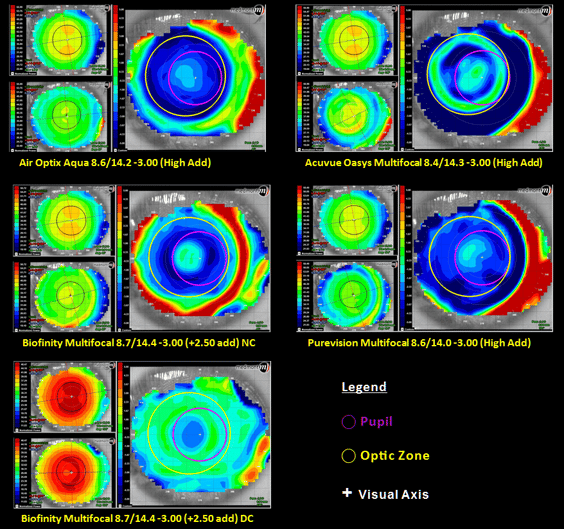When fitting soft multifocal contact lenses, it is important to remember that many factors contribute to a successful outcome. One often overlooked component of success is the appropriate alignment of the multifocal optics with a patient’s visual axis. When there is a misalignment between the center of the multifocal optics and the patient’s visual axis, patients can experience poor visual acuity, induced aberrations and have subjective complaints of glare, shadows, 3-D effects and halos. Dr. Matthew Lampa et al. began studying this issue by re-purposing the corneal topographer to measure the surface profile of four commercially available brands of soft, simultaneous-designed, multifocal contact lenses. Below is a summary of this study.
Study
To highlight the misalignment between the center of the multifocal optics and a patient’s visual axis, Dr. Lampa first performed corneal topography for 18 subjects without contact lenses on the eye. After allowing lenses to settle and confirming appropriate fit with a slit lamp exam, each of the subjects then underwent corneal topography while wearing five different commercially available soft multifocal contact lenses. Finally, utilizing the Medmont topographer’s difference display setting, the amount of misalignment between the center of the multifocal optics and the patient’s visual axis was evaluated.
Upon examining the difference display maps, Dr. Lampa found that the centers of the multifocal optics were consistently displaced temporally to the patient’s visual axis, with the amount of misalignment ranging from 0 – 1.25mm.1 Examples of these misalignments are shown in Figure 1.

Figure 1. Results of corneal mapping over commercially available soft multifocal contact lenses.
In these cases, the misalignment is thought to be related to the discrepancy between the pupillary axis and the visual axis (angle kappa).1 Angle kappa is formed due to the temporal position of the fovea and the nasally displaced corneal light reflex.2-4 Similar to multifocal intraocular lenses, when multifocal contact lens patients have a larger angle kappa, a fovea centric light ray can pass through the edge of a multifocal zone and cause reduced vision and photic phenomena such as halos, glare and 3-D effects.5 Below are examples of the clinical feedback from patients that experienced this misalignment:
- “My vision is clear, but seems a bit off.”
- “My eyes feel strained with the lenses on.”
- "I can’t explain….something just doesn’t seem right.”
Conclusion
With the success of soft multifocal contact lens fittings being multifactorial, this study highlights the importance of evaluating a potential misalignment between the center of the multifocal optics and the patient’s visual axis. For step by step instructions on how to identify or predict these issues, be sure to review our “3 Ways to Identify a Misalignment.” Additionally, if you suspect that your multifocal patient may be suffering from such an issue, contact SpecialEyes and ask about our new OptiSync® Technology, which allows you to shift (offset) the multifocal optics from the center of the lens and target alignment with the patient’s visual axis.
References
1 Lampa, Matthew; Kelvin So; et al. “Assessing Soft Multifocal Contact Lens Centration With the Aid of Corneal Topography.” Poster presented at the Global Specialty Lens Symposium; 2013.
2 Park, Choul Yong; Sei Yeul Oh; and Roy S. Chuck. “Measurement of Angle Kappa and Centration in Refractive Surgery.” Current Opinion in Ophthalmology, vol. 23, no. 4; 2012; pp. 269–275.
3 Moshirfar, Majid; Ryann Hoggan; and Valliammai Muthappan. "Angle Kappa and Its Importance in Refractive Surgery." Oman Journal of Ophthalmology, vol. 6, no. 3; 2013; pp. 151–157.
4 Colin C.K. Chan and Brian S. Boxer Wachler. “Centration Analysis of Ablation Over the Coaxial Corneal Light Reflex for Hyperopic LASIK.” Journal of Refractive Surgery, vol. 22, no. 5; 2006; pp. 467–471.
5 Prakash, Gaurav; Amar Agarwal; et al. “Role of Angle Kappa in Patient Dissatisfaction With Refractive-Design Multifocal Intraocular Lenses.” Journal of Cataract Refractive Surgery, vol. 37, no. 9; 2011; pp. 1739–1740.
